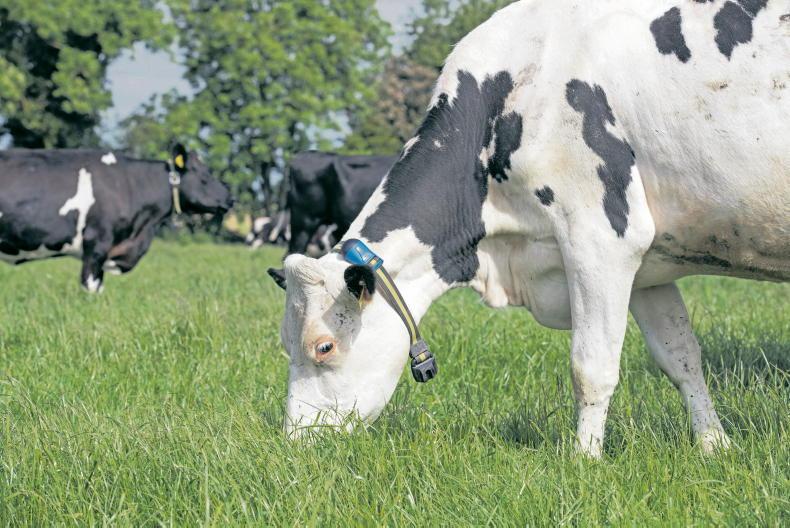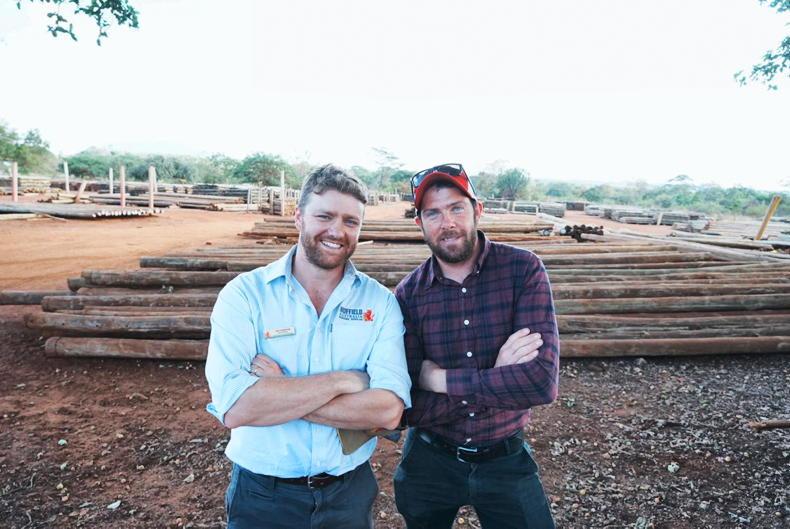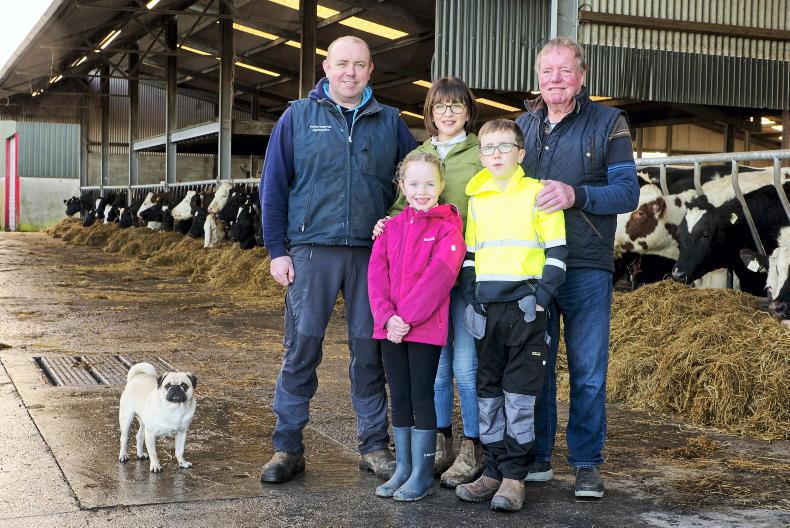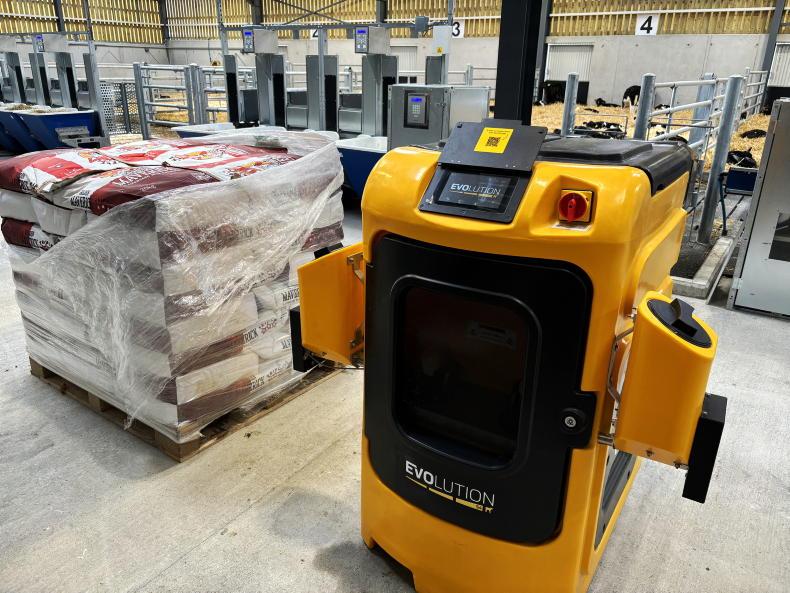Reduced margins in dairy farming may be taking some of the gloss off farmers’ ability to spend on gadgets, but interest in automated heat detection aids remains strong.
Often referred to as cow collars, automated heat detection aids come in a variety of forms, including ear tags and rumen boluses. Wearables is a better term to use when describing automated heat detection aids.
Depending on the level of spec chosen, wearables will detect health and heat events by constantly monitoring cow behaviour.
Activity, rumination time and, in some devices, temperature are used to identify cows that are sick or are bulling.
This activity is fed into a computer programme and the algorithm will alert the farmer if it identifies behaviour that indicates something is wrong, or the cow is bulling.
Most of this technology is not new and is around for 15 years, or more, albeit with regular updates to the device hardware and software.
New Zealand company Halter has probably got the most innovative technology on the market, as its wearables can allocate grass and move cows between paddock and yard (see more on the opposite page). The question is often asked by farmers if wearables lead to improved outcomes.
To answer this, we need to be clear about what outcomes the farmers are referring to.
In New Zealand, Livestock Improvement Corporation (LIC) monitors fertility performance across the New Zealand dairy herd.
Recently, LIC put the breeding data together for 4,586 herds bred last season, which encompasses over 2.46m dairy cows. Of the 4,586 herds in the analysis, 870 were using wearables.
Table 1 looks at the fertility performance broken down between herds with wearables and those without wearables. While not a controlled experiment, the massive size of the dataset more than makes up for the differences in management between farms, so it’s reliable.
The main takeaway for me is that there is no real difference in fertility performance between herds with wearables and those without.
The submission rate was higher in herds with wearables, but the conception rate was lower and the six-week in-calf rate was slightly higher for herds with wearables at 69.4% versus 69.2%.
The overall empty rate was slightly lower for herds without wearables at 15.4% empty after 10.4 weeks of breeding; while the empty rate for herds with wearables was higher at 15.9% after a slightly longer breeding season at 10.8 weeks.
The greatest difference was in submission rate, with 80.2% submitted on herds without wearables and 83.8% submitted on herds with wearables.
It looks to me that some of the extra cows submitted on herds with wearables weren’t actually in heat because while the submission rate was higher, the conception rate was lower at 52.7% versus 53.2% on herds without wearables.
Based on the New Zealand experience, it’s safe to infer that automated heat detection aids don’t improve fertility performance.
This makes sense, because wearables are relying on secondary signs of heat whereas those not using wearables are relying on primary signs of heat – mounting or standing heat.
The argument is often made that extra operator skill or experience is required to identify cows in heat where there are no wearables.
Tail paint is really easy to use and is a reliable guide to identifying cows in heat
While this may be true to a degree, there is a wide range of operator skill on New Zealand farms without wearables and they had lower empty rates than herds with wearables.
Tail paint is really easy to use and is a reliable guide to identifying cows in heat. If the paint is gone, the cow should be inseminated.
Of course, if existing heat detection is poor then investing in wearables will dramatically improve fertility outcomes, but so too would improving heat detection using traditional methods.
While the breeding outcomes may not be much better with wearables, there is no doubt that they do reduce the workload associated with breeding. When combined with a drafting gate, the cows that are required for AI are presented in a pen after each milking without any physical input by the operator.
To me, the labour benefits of automated heat detection systems are the key selling point.
Not having to tail paint cows and not having to identify cows in heat does reduce time and stress and that’s real and tangible. If it means the farm manager or owner-operator can get more time off and rely on relief staff at weekends during the breeding season, well then that’s a big advantage.
Others point to improved timing of AI, which is important for sexed semen use.
Most of the software packages include an optimum time for AI and while useful, whether it is any better than monitoring tail paint and using the AM-PM rule is hard to tell.
New Zealand-based company Halter has developed a cow collar that not only detects heat and health events but also GPS-guided virtual fencing. This allocates grass and moves cows to new paddocks or to the milking parlour.
The device works by training cows to move left or right based on sounds and vibrations to the solar-powered cow collar.
The system is seen by many in New Zealand as the next step in pasture management, as traditional fences are no longer needed, so cows are moved as soon as the correct residual is met. It incorporates an app that farmers can upload photos of the grazing residual to and uses satellite imagery to monitor grass on the farm.
Artificial intelligence will automatically adjust the grazing area to take account of the residual that is left in the allocated grazing area. A number of high-profile New Zealand farmers are using Halter on their farms, including traditional low-cost farmers Leonie Guiney and Pete Morgan.
The system claims to improve grass utilisation and grass growth and reduce labour.
Halter told the Irish Farmers Journal that it would need to adapt its technology for Irish conditions, but it is keen to operate and serve Irish farmers in the future.
TAMS III grant aid is available for farmers to assist in the purchase of automated heat detection aids at a rate of 40% off the reference cost or 60% in some situations.

Herd health dairy monitoring technology is applicable for grant aid with TAMS III.
The reference cost for the base station is given as €2,833, with the costs for the cow units based on a per collar/tag/bolus basis is €112.25/unit up to a maximum of 120 units.
The specifications state that the on-cow recording system can be either a bolus, tag or collar-mounted system, with the system having to be able to identify when cows/heifers are in-heat and identify the relevant animal(s) to the farmer in a timely manner.
Booster stations or relay antenna are not eligible for grant aid unless they have the capability of operating the health and fertility monitoring system on their own.
Installations that just boost the signal or enhance the range from the base station are not eligible for grant aid as a base station. Grant aid is only available on the capital cost of devices.
For flat-rate VAT farmers, while every case is said to be assessed on its own merits, it is extremely unlikely that a VAT reclaim can be made on either the base station or the device wearables. However, if a drafting gate is to be installed, VAT can be claimed back on this. TAMS grant is also available on drafting gates with a reference cost of €12,500.
Reduced margins in dairy farming may be taking some of the gloss off farmers’ ability to spend on gadgets, but interest in automated heat detection aids remains strong.
Often referred to as cow collars, automated heat detection aids come in a variety of forms, including ear tags and rumen boluses. Wearables is a better term to use when describing automated heat detection aids.
Depending on the level of spec chosen, wearables will detect health and heat events by constantly monitoring cow behaviour.
Activity, rumination time and, in some devices, temperature are used to identify cows that are sick or are bulling.
This activity is fed into a computer programme and the algorithm will alert the farmer if it identifies behaviour that indicates something is wrong, or the cow is bulling.
Most of this technology is not new and is around for 15 years, or more, albeit with regular updates to the device hardware and software.
New Zealand company Halter has probably got the most innovative technology on the market, as its wearables can allocate grass and move cows between paddock and yard (see more on the opposite page). The question is often asked by farmers if wearables lead to improved outcomes.
To answer this, we need to be clear about what outcomes the farmers are referring to.
In New Zealand, Livestock Improvement Corporation (LIC) monitors fertility performance across the New Zealand dairy herd.
Recently, LIC put the breeding data together for 4,586 herds bred last season, which encompasses over 2.46m dairy cows. Of the 4,586 herds in the analysis, 870 were using wearables.
Table 1 looks at the fertility performance broken down between herds with wearables and those without wearables. While not a controlled experiment, the massive size of the dataset more than makes up for the differences in management between farms, so it’s reliable.
The main takeaway for me is that there is no real difference in fertility performance between herds with wearables and those without.
The submission rate was higher in herds with wearables, but the conception rate was lower and the six-week in-calf rate was slightly higher for herds with wearables at 69.4% versus 69.2%.
The overall empty rate was slightly lower for herds without wearables at 15.4% empty after 10.4 weeks of breeding; while the empty rate for herds with wearables was higher at 15.9% after a slightly longer breeding season at 10.8 weeks.
The greatest difference was in submission rate, with 80.2% submitted on herds without wearables and 83.8% submitted on herds with wearables.
It looks to me that some of the extra cows submitted on herds with wearables weren’t actually in heat because while the submission rate was higher, the conception rate was lower at 52.7% versus 53.2% on herds without wearables.
Based on the New Zealand experience, it’s safe to infer that automated heat detection aids don’t improve fertility performance.
This makes sense, because wearables are relying on secondary signs of heat whereas those not using wearables are relying on primary signs of heat – mounting or standing heat.
The argument is often made that extra operator skill or experience is required to identify cows in heat where there are no wearables.
Tail paint is really easy to use and is a reliable guide to identifying cows in heat
While this may be true to a degree, there is a wide range of operator skill on New Zealand farms without wearables and they had lower empty rates than herds with wearables.
Tail paint is really easy to use and is a reliable guide to identifying cows in heat. If the paint is gone, the cow should be inseminated.
Of course, if existing heat detection is poor then investing in wearables will dramatically improve fertility outcomes, but so too would improving heat detection using traditional methods.
While the breeding outcomes may not be much better with wearables, there is no doubt that they do reduce the workload associated with breeding. When combined with a drafting gate, the cows that are required for AI are presented in a pen after each milking without any physical input by the operator.
To me, the labour benefits of automated heat detection systems are the key selling point.
Not having to tail paint cows and not having to identify cows in heat does reduce time and stress and that’s real and tangible. If it means the farm manager or owner-operator can get more time off and rely on relief staff at weekends during the breeding season, well then that’s a big advantage.
Others point to improved timing of AI, which is important for sexed semen use.
Most of the software packages include an optimum time for AI and while useful, whether it is any better than monitoring tail paint and using the AM-PM rule is hard to tell.
New Zealand-based company Halter has developed a cow collar that not only detects heat and health events but also GPS-guided virtual fencing. This allocates grass and moves cows to new paddocks or to the milking parlour.
The device works by training cows to move left or right based on sounds and vibrations to the solar-powered cow collar.
The system is seen by many in New Zealand as the next step in pasture management, as traditional fences are no longer needed, so cows are moved as soon as the correct residual is met. It incorporates an app that farmers can upload photos of the grazing residual to and uses satellite imagery to monitor grass on the farm.
Artificial intelligence will automatically adjust the grazing area to take account of the residual that is left in the allocated grazing area. A number of high-profile New Zealand farmers are using Halter on their farms, including traditional low-cost farmers Leonie Guiney and Pete Morgan.
The system claims to improve grass utilisation and grass growth and reduce labour.
Halter told the Irish Farmers Journal that it would need to adapt its technology for Irish conditions, but it is keen to operate and serve Irish farmers in the future.
TAMS III grant aid is available for farmers to assist in the purchase of automated heat detection aids at a rate of 40% off the reference cost or 60% in some situations.

Herd health dairy monitoring technology is applicable for grant aid with TAMS III.
The reference cost for the base station is given as €2,833, with the costs for the cow units based on a per collar/tag/bolus basis is €112.25/unit up to a maximum of 120 units.
The specifications state that the on-cow recording system can be either a bolus, tag or collar-mounted system, with the system having to be able to identify when cows/heifers are in-heat and identify the relevant animal(s) to the farmer in a timely manner.
Booster stations or relay antenna are not eligible for grant aid unless they have the capability of operating the health and fertility monitoring system on their own.
Installations that just boost the signal or enhance the range from the base station are not eligible for grant aid as a base station. Grant aid is only available on the capital cost of devices.
For flat-rate VAT farmers, while every case is said to be assessed on its own merits, it is extremely unlikely that a VAT reclaim can be made on either the base station or the device wearables. However, if a drafting gate is to be installed, VAT can be claimed back on this. TAMS grant is also available on drafting gates with a reference cost of €12,500.











SHARING OPTIONS